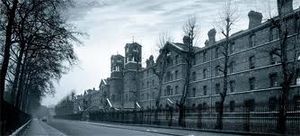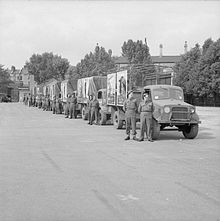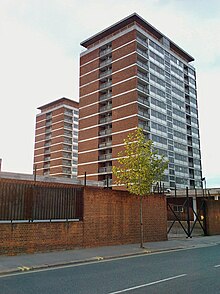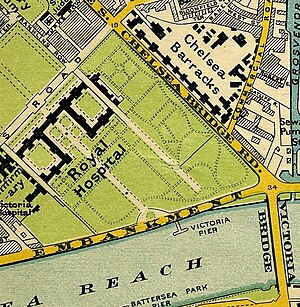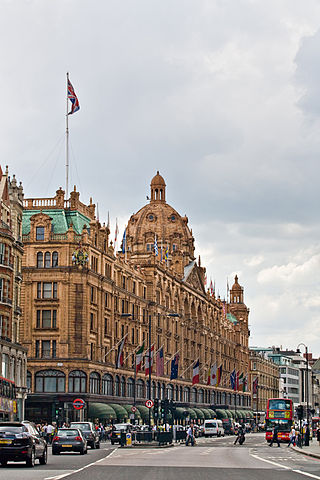
Knightsbridge is a residential and retail district in central London, south of Hyde Park. It is identified in the London Plan as one of two international retail centres in London, alongside the West End. Knightsbridge is also the name of the roadway which runs near the south side of Hyde Park from Hyde Park Corner.

St John's Wood is a district in the City of Westminster, London, England, about 2.5 miles (4 km) northwest of Charing Cross. Historically the northern part of the ancient parish and Metropolitan Borough of Marylebone, it extends from Regent's Park and Primrose Hill in the east to Edgware Road in the west, with the Swiss Cottage area of Hampstead to the north and Lisson Grove to the south.

Battersea Power Station is a decommissioned coal-fired power station located on the south bank of the River Thames in Nine Elms, Battersea in the London Borough of Wandsworth. It was built by the London Power Company (LPC) to the design of Leonard Pearce, Engineer in Chief to the LPC, and CS Allott & Son Engineers. The architects were J. Theo Halliday and Giles Gilbert Scott. The station is one of the world's largest brick buildings and notable for its original, Art Deco interior fittings and decor.

Paddington Basin is the name given to a long canal basin, and its surrounding area, in Paddington, London.

Richard George Rogers, Baron Rogers of Riverside, was a British-Italian architect noted for his modernist and constructivist designs in high-tech architecture. He was the founder at Rogers Stirk Harbour + Partners, previously known as the Richard Rogers Partnership, until June 2020. After Rogers' retirement and death, the firm rebranded to simply RSHP on 30 June 2022.

Wood Wharf is a 23 acre site in Canary Wharf, London. It is currently under construction to provide offices, residential homes and retail space. The site is next to Canary Wharf. Wood Wharf will contain 5 million square feet of space, which will include 2 million sq ft of office space, 3,330 residential homes, 3.6 hectares of public spaces, and 380,000 sq ft of shops, restaurants and space for community use. It is estimated to be completed in 2023.

122 Leadenhall Street, which is also known as the Leadenhall Building, is a 225-metre-tall (738 ft) skyscraper in central London. It opened in July 2014 and was designed by the Rogers Stirk Harbour + Partners; it is known informally as The Cheesegrater because of its distinctive wedge shape, similar to that of the kitchen utensil of the same name. It is one of numerous tall buildings recently completed or under construction in the City of London financial district, including 20 Fenchurch Street, 22 Bishopsgate and The Scalpel.

The Embassy of the United States of America in London is the diplomatic mission of the United States in the United Kingdom. It is located in Nine Elms and is the largest American embassy in Western Europe and the focal point for events relating to the United States held in the United Kingdom.

Allies and Morrison LLP is an architecture and urban planning practice based in London and Cambridge. Founded in 1984, the practice is now one of Britain's largest architectural firms. The practice's work ranges from architecture and interior design to conservation and renovation of historic buildings to urbanism, planning, consultation and research. The firm's notable projects include the redevelopment of the Royal Festival Hall, the masterplan for the Queen Elizabeth Olympic Park, BBC Media Village and the redevelopment of King's Cross Central. The practice has a reputation for designing modernist, yet stylistically restrained buildings.

Exhibition Road is a street in South Kensington, London which is home to several major museums and academic establishments, including the Victoria and Albert Museum, the Science Museum and the Natural History Museum.

RSHP is a British architectural firm, founded in 1977 and previously known as the Richard Rogers Partnership which became Rogers Stirk Harbour + Partners in 2007. The firm rebranded from Rogers Stirk Harbour + Partners to simply RSHP on 30 June 2022, after the retirement and subsequent death of Richard Rogers on 18 December 2021. Its main offices are located in the Leadenhall Building, London, completed to the firm's designs in 2014. Previously, they were at the Thames Wharf Studios. In its various incarnations RSHP has designed many important buildings including the Lloyd's building and the Millennium Dome in London and the Senedd building in Cardiff.
Nicholas Anthony Christopher Candy and Christian Peter Candy are British luxury property developers. The brothers were estimated to share a joint net worth of £1.5 billion in the Estates Gazette rich list 2010, placing them at position 52 in the list of the richest property developers in the United Kingdom.

Fitzroy Place is an office, residential and retail estate in Fitzrovia, London. With 289 homes, with interiors designed by Johnson Naylor, and 220,000 sq ft of office space, Fitzroy Place houses a series of shops and restaurants, offices and community spaces, set around a publicly accessible central square. The square, which was the first new garden square in W1 for 100 years, incorporates the Grade II* listed Fitzrovia Chapel.

The Qatar Investment Authority is Qatar's sovereign wealth fund. The QIA was founded by the State of Qatar in 2005 to strengthen the country's economy by diversifying into new asset classes. In October 2023, the QIA has an estimated $475 billion of assets under management.

Lifschutz Davidson Sandilands is a practice of architects, urban designers and masterplanners established in 1986 and practising out of London.

East Village is an area in Stratford, East London that was designed and constructed as the Olympic Village of the 2012 Summer Olympics and has been converted for use as a new residential district, complete with independent shops, bars and restaurants. The area was formerly contaminated waste land and industrial buildings to the north of Stratford town centre. More than 7,000 people now live in the area.
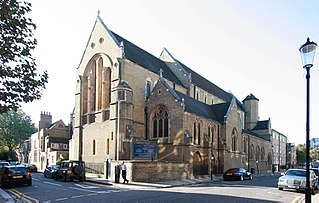
St Mary's, Cadogan Street, is a Grade II* listed Roman Catholic church in Cadogan Street, Chelsea, London. It was built between 1877 and 1879 by John Francis Bentley, most notable for his work as architect of Westminster Cathedral, and is one of the oldest Roman Catholic parishes in Central London.
Delancey Real Estate Asset Management Limited is a British property development company that has wholly owned subsidiaries such as DV4 based in offshore jurisdictions. The billionaire George Soros invested in the company in 1998. The company appears in the Panama papers. In 2011, the Qatari ruling family bought the Olympic Village used in the London 2012 Olympic Games. The area has been renamed the East Village.
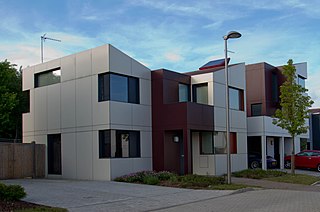
Oxley Woods is a housing development in Oxley Park, a district of Milton Keynes, Buckinghamshire, England. The development was designed by Rogers Stirk Harbour + Partners and built by Newton Woods, who were subcontracted by Taylor Wimpey after winning the Office of the Deputy Prime Minister's Design for Manufacture Competition, which was run by English Partnerships in 2005.
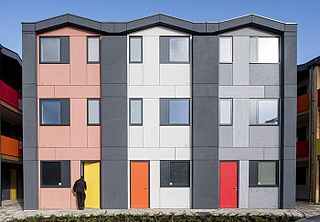
Y:Cube is a three-storey block of 36 one-bedroom affordable housing flats, owned by YMCA St Paul’s Group. They include George William Court, 148 Clay Avenue and flats 36A-E Woodstock Way in Mitcham in London, England. George William Court was named after the founder of YMCA, George Williams.
